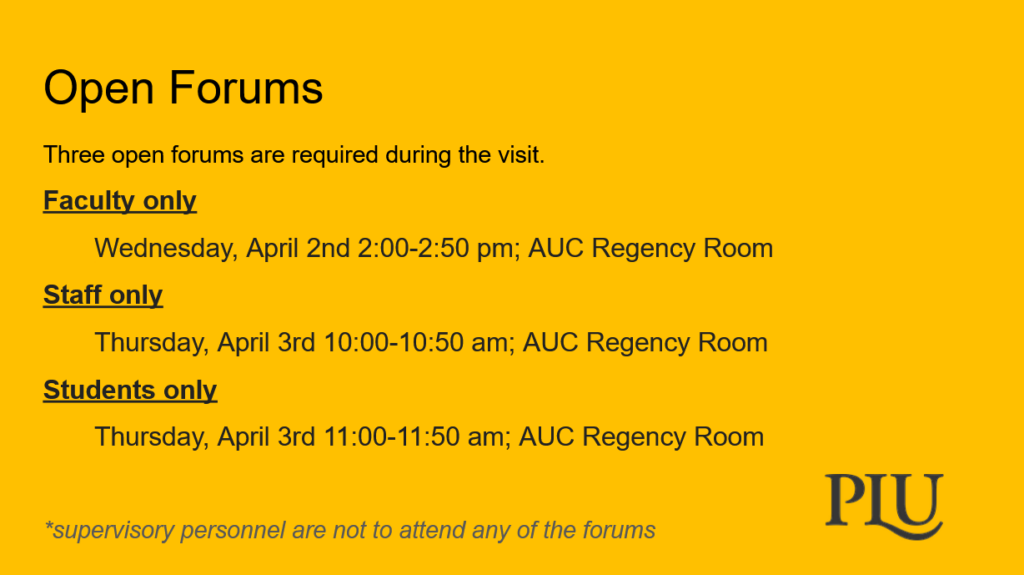PLU Public Disclosure:
Pacific Lutheran University is a member of the Northwest Commission on Colleges and Universities (NWCCU). NWCCU is an institutional accrediting agency recognized by the U.S. Secretary of Education and the Council for Higher Education Accreditation (CHEA).
PLU is fully accredited and in good standing with the NWCCU. The commission will conduct an Evaluation of Institutional Effectiveness of Pacific Lutheran University on April 2-4, 2025. The Evaluation of Institutional Effectiveness is the culminating evaluation of the current seven-year accreditation cycle. A successful report and visit is necessary to maintain our accreditation standing with the commission. The last comprehensive evaluation and visit of the university occurred in the Spring of 2018. Since then, Pacific Lutheran University has successfully undertaken a Year One Report (2019), A Mid-Cycle Report (2021); and the Policies, Regulations and Financial Report and review (2024).
Public comments related to the accreditation of PLU may be submitted to the NWCCU no later than March 21, 2025. Comments may be submitted via the NWCCU website or by mail at the addresses provided below. Details about Pacific Lutheran University’s accreditation cycle, along with past reports and Commission Letters can be found on the university’s Accreditation webpage.
Send comments via electronic submission at:
https://nwccu.org/upcoming-evaluations/
Send comments via mail to:
Attn: Third-Party Comment
8060 165th Ave NE, Suite 200
Redmond, WA 98052
Per the year seven accreditation visit, the accreditation team hold three open forums: faculty only, staff only, and students only.
The dates and times of these forums are listed below.
Please note, if you are in any supervisory role you are not to attend.

Pacific Lutheran University is accredited by the Northwest Commission on Colleges and Universities (NWCCU).
Regional accreditation is a process of recognizing educational institutions for performance, integrity, and quality that entitles them to the confidence of the educational community and the public. In the United States this recognition is extended largely through nongovernmental, voluntary membership associations that establish accreditation criteria, evaluate institutions against those criteria, and approving institutions that meet the criteria.
The NWCCU accreditation process is represented by a seven-year cycle of written reports and visits by evaluation committees. The current calendar for PLU is:
| Annual Report | August 15, 2020 |
| Mid-Cycle Report | March 15, 2021 |
| Evaluation (site visit) | April 22-23, 2021 |
| Annual Report | August 15, 2021 |
| Annual Report | August 15, 2022 |
| Annual Report | August 15, 2023 |
| Policies, Regulations, and Financial Review (PRFR) | February 15, 2024 |
| Annual Report | August 15, 2024 |
| Evaluation of Institutional Effectiveness (EIE – Year Seven Report and site visit) | February 15, 2025 |
Mission Fulfillment
Through the seven-year accreditation cycle, PLU articulates how it evaluates continued progress toward Mission Fulfillment. Progress is defined using three distinct but overlapping pathways:
Vision and Strategic Planning
- The strategic plan reflects a vision narrative that explicitly calls out our commitments to innovation; pathways to distinction; undergraduate programs; graduate and continuing education; student life and success; and diversity, justice and sustainability. Through the act of intentional planning, and through the deliberate execution of our plans, we progress in both the embodiment and the realization of our mission. The current university strategic plan is organized around four overarching themes and corresponding goals: identity and messaging, environment and well-being, innovation and change, and resources and stewardship. These themes and goals were developed to reflect and extend upon key priorities and values expressed in parallel vision and planning documents: the strategic enrollment management plan, the diversity and inclusion strategic plan, and the academic identity statement.
Core Themes and Objectives
- In order to best realize mission fulfillment, we work to ensure alignment between our Core Themes and Objectives and the University Strategic Plan. As both documents are designed to reflect the institution’s mission and traditions, this alignment is anticipated to be natural. Unlike strategic planning which reflects a series of priorities in a moment in time, the Core Themes and Objectives are designed to reflect our most enduring values and commitments. In these ways the Core Themes and Objectives and the specific outcomes identified in the University Strategic Plan should complement each other or duplicate as appropriate.
Quality Improvement
- The ability to successfully fulfill our mission is dependent on ensuring that key services and personnel meet and exceed standards of performance. The collection of this data, to the greatest degree possible, occurs in a regular and on-going basis as a part of normal operations in the University. Key accountability measures occur in the form of academic and student life program reviews, faculty reviews, staff reviews and peer comparisons of student achievement indicators. Accountability processes and utilization of key findings vary by review type and purpose.


